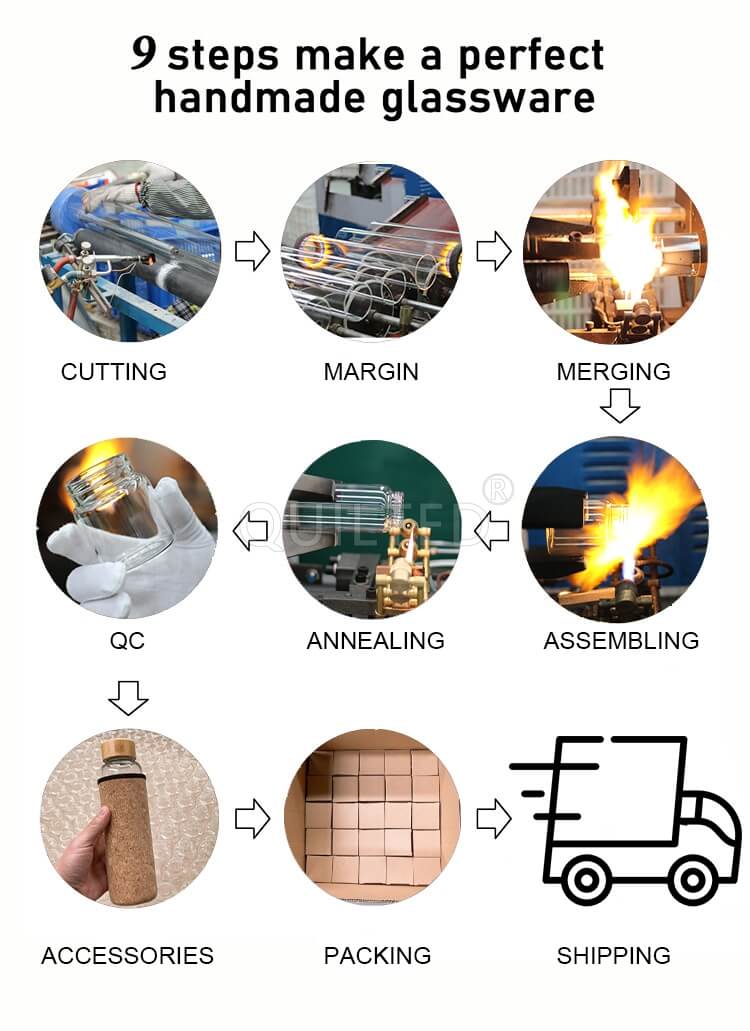In the glass bottle production process, manufacturers often apply frosting technology to enhance the aesthetic appeal of wine bottles. Frosting provides a unique decorative effect, making the bottles stand out with a frosted, translucent surface and intricate patterns.
1. Introduction to Frosting Technology
Frosting is a decorative process where glass glaze powder is adhered to specific areas of a glass surface. This process involves:
- Application of Glaze Powder: The glass-colored glaze powder is applied through techniques like brushing, roller coating, or silk-screen printing.
- Heat Treatment: The coated glass is baked at temperatures between 580–600°C, melting the glaze into the surface and creating a frosted appearance distinct from the main glass body.
- Pattern Formation: Using silk-screen printing, a flux is applied to form designs. During the baking process:
- Fused Frosting: The frosted surface without the flux inhibitor melts into the glass.
- Resistant Patterns: Areas with flux remain unfused, leaving behind transparent patterns amidst the frosted backdrop.
This process creates an elegant visual effect, often used for branding or decorative purposes in wine bottle design.
2. Care and Storage of Glass Bottles
Proper handling and storage of glass bottles are essential to maintain their quality and appearance.
- Inspecting Bottles:
- Check for missing components such as caps, labels, or other essential elements.
- For wine bottles with disposable anti-counterfeiting caps, ensure the caps and connectors are preserved after opening.
- Maintaining Appearance:
- Handle bottles carefully to avoid scratches, chips, or defects that can reduce their value.
- Preserve the integrity of the bottle’s label, as it serves as the bottle’s “ID card.”
- Proper Cleaning:
- For general cleaning, use detergent and warm water.
- For stubborn stains, use a fine cloth with decontamination powder or warm vinegar for better results.
3. Why Frosting Enhances Glass Bottles
Frosting not only adds visual appeal but also serves practical purposes:
- Brand Differentiation: Customized frosted patterns and textures help distinguish a brand.
- Durability: The baked glaze coating enhances the surface’s resistance to wear and tear.
- Luxury Appeal: Frosted finishes are associated with premium and high-end products, adding perceived value.
Conclusion
Frosting technology is a creative and functional method to elevate the aesthetics of glass bottles. By combining careful production techniques with proper storage and maintenance, manufacturers and consumers alike can preserve the beauty and quality of glass bottles. This ensures they remain both functional and visually appealing, meeting the expectations of a competitive market.
There are a lot of glass bottle production process, some manufacturers in order to make wine bottles more beautiful ill be frosting process. What is frosting technology?
1. Introduction of sand coating technology of glass bottle
Frosting is a kind of decoration method that adheres a certain area of glass colored glaze powder on the glass products, and after baking at 580 ~ 600 ℃, the glass colored glaze coating melts on the surface of the glass, and shows a different color from the main body of the glass.Adhesive glass glaze powder, can be brush brush, can also be roller coating.Through silk printing, the empty pattern of sand covered surface can be obtained.
The method is: On the surface of glass products, screen printing a layer of patterns formed by flux.To be printed on the pattern after air drying, then frosting processing.After baking at high temperature, the frosted surface without pattern will melt on the glass surface, while the frosted surface on the screen printing pattern can not be fused on the glass surface due to the effect of flux inhibitor.After baking, the transparent pattern of the floor space will appear through the translucent sand surface, forming a special decorative effect.It is composed of ferric oxide, talcum powder and clay. It is ground by ball mill with fineness of 350 mesh. It is mixed with adhesive before screen printing.
2. We should be careful to distinguish when we store glass bottles
First check the bottle is not missing:There are no missing glass wine bottles, including bottle body, bottle cap and bottle label. Some wineries choose disposable anti-counterfeiting caps. After opening the caps, they are thrown away because they are damaged. After opening the caps, the depositors should put away the caps and connectors.
Then there is the appearance of the glass bottle:If some glass bottles have small defects due to fine bumping, they will seriously affect their value.So we should try our best to ensure the appearance of the wine bottle and handle it with care.
And the identity of the glass bottle:To distinguish whether a container is a wine bottle, the only symbol should be the wine label. Therefore, the depositor must not damage the wine label on the bottle. After all, it is the ID card to prove that the container is a wine bottle.To distinguish whether a container is a wine bottle.
Attention should be paid to the maintenance of glass wine bottles after preservation,Glass bottles craft these glassware are simple and dirty.General glass bottles in use, with detergent to wash it.If you use it for a long time and accumulate more stains, you should use a fine cloth dipped in decontamination powder to repeatedly scrub, or use a fine cloth dipped in warm vinegar to scrub, the decontamination effect will be better.
Post time: Dec-08-2024

